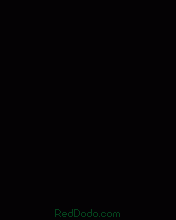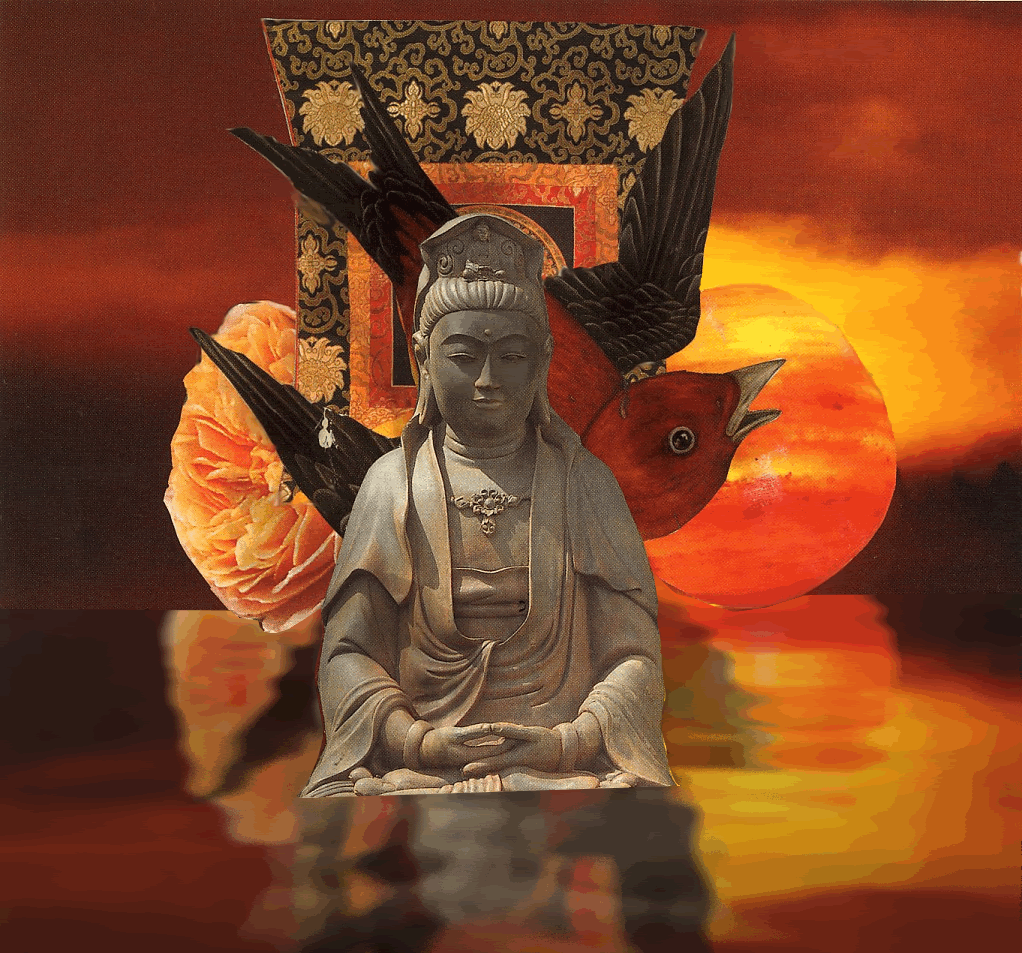30 04 2012 MONDAY LESSON 595 FREE ONLINE eNālāndā
Research And Practice UNIVERSITY And
THE BUDDHISTONLINE GOOD NEWS LETTER by ABHIDHAMMA RAKKHITA through http://sarvajan.ambedkar.org
Dhammapada:
Verses and Stories Body Fattens - Mind Does Not
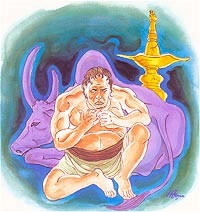
Verse
152. Body Fattens - Mind Does Not
Just as the ox grows old
so this man of little learning:
his fleshiness increases,
his wisdom doesn’t grow.
Explanation: The person who has scarcely heard the Teaching
grows in physique, like a fattened bull. Although his body grows, his self
understanding does not.
V.
FIVE TYPES OF BUDDHIST STUDY AND PRACTICE
MAHAYANA AND HINAYANA COMPARED
PURE LAND
BUDDHA RECITATION
EIGHT CONSCIOUSNESSES
ONE HUNDRED DHARMAS
ONE HUNDRED DHARMAS
http://www.drbu.org/dictionary/one-hundred-dharmas
One
Hundred Dharmas
The
One Hundred Dharmas are a general categorization of all dharmas according to
the Consciousness-Only School of the Mahayana.
All lists of dharmas are distinction-making for the purpose of
breaking attachment to harmful distinctions about our minds and the physical
world that are based on attachment to self. Other general categorizations of
all dharmas include the five skandhas and the eighteen realms.
The One Hundred Dharmas make distinctions that are more specific
and form the basis for a sophisticate and detailed Buddhist psychology of mind.
They include:
11 Form Dharmas (five skandhas—form)
8 Mind Dharmas (eight consciousnesses)
51 Dharmas Interactive with the Mind
24 Dharmas Not Interactive with the Mind
+6 Unconditioned Dharmas
—————————————————————
100 Dharmas
The One Hundred Dharmas are listed individually and discussed in
detail in the Śāstra on the Door to Understanding the Hundred Dharmas (HD).
Chinese
Terms
百法
http://www.cttbusa.org/100shastra/100dharmas1.asp
![]() THE SAGELY CITY OF TEN
THE SAGELY CITY OF TEN
THOUSAND BUDDHAS

http://online.sfsu.edu/~rone/Buddhism/Yogacara/BasicVersesAppendc.htm
http://buddhasandsages.wordpress.com/2010/03/02/100-dharmas/
http://www.acmuller.net/yogacara/outlines/100dharmas-big5.htm
The One Hundred
Dharmas
百法
Dan
Lusthaus
Based
on Vasubandhu’s Baifa mingmen lun 百法明門論
Mahaayaana `satadharmaa-prakaa`samukha `saastra
(Lucid Introduction to the One Hundred Dharmas)
T.31.1614
I. The Eight
Consciousnesses Citta-dharma 心法,八識
1. |
cak.sur-vij~naana |
眼識 |
2. |
`srotra-vij~naana |
耳識 |
3. |
ghraa.na-vij~naana |
鼻識 |
4. |
jihvaa-vij~naana |
舌識 |
5. |
kaaya-vij~naana |
身識 |
6. |
mano-vij~naana |
意識 |
7. |
manas |
意 |
8. |
aalaya-vij~naana |
阿賴耶識 |
II. Mental Associates
caitta, caitasika-dharma 心所法
citta-samprayukta-dharma
心相應法
A
Always-active
Sarvatraga 遍行
9. |
spar`sa |
觸 |
10. |
vedanaa |
受 |
11. |
cetanaa |
思 |
12. |
sa.mj~naa |
想 |
13. |
manaskaara |
作意 |
B
Specific
Viniyata 別境
14. |
chanda |
欲 |
15. |
adhimok.sa |
勝解 |
16. |
sm.rti |
念 |
17. |
samaadhi |
定 |
18. |
praj~naa |
慧 |
C
Advantageous
Ku`sala 善
19. |
`sraddhaa |
信 |
20. |
hrii |
慚 |
21. |
apatraapya |
愧 |
22. |
alobha |
無貪 |
23. |
adve.sa |
無瞋 |
24. |
amoha |
無痴 |
25. |
viirya |
精進 |
26. |
pra`srabdhi |
輕安 |
27. |
apramaada |
不放逸 |
28. |
upek.sa |
行捨 |
29. |
ahi.msaa |
不害 |
D
Mental
Disturbances Kle`sa 煩惱
30. Appropriational intent |
raaga |
貪 |
31. Aversion |
pratigha |
瞋 |
32. Stupidity |
muu.dhi |
痴 |
33. Arrogance |
maana |
慢 |
34. Doubt |
vicikitsaa |
疑 |
35. Perspectivality |
d.r.s.ti |
惡見 |
E
Secondary Mental
Disturbances Upakle`sa 隨煩惱
36. Anger |
krodha |
忿 |
|
37. Enmity |
upanaaha |
恨 |
|
38. Resist recognizing own faults |
mrak.sa |
覆 |
|
39. [verbal] maliciousness |
pradaasa |
惱 |
|
40. Envy |
iirasyaa |
嫉 |
|
41. Selfishness |
maatsarya |
慳 |
|
42. Deceit |
maayaa |
誑 |
|
43. Guile |
`saa.thya |
諂 |
|
44. Harmfulness |
vihi.msaa |
害 |
|
45. Conceit |
mada |
憍 |
|
46. Shamelessness |
aahriikya |
無慚 |
|
47. Non-embarrassment |
anapatraapya |
無愧 |
|
48. Restlessness |
auddhatya |
掉舉 |
|
49. Mental fogginess |
styaana |
惛沈 |
|
50. Lack of Faith/trust |
aa`sraddhya |
不信 |
|
51. Lethargic negligence |
kausiidya |
懈怠 |
|
52. Carelessness |
pramaada |
放逸 |
|
53. Forgetfulness |
mu.sitasm.rtitaa |
失念 |
|
54. Distraction |
vik.sepa |
散亂 |
|
55. Lack of [self-]Awareness |
asa.mprajanya |
不正知 |
|
F
Indeterminate Aniyata
不定
56. Remorse |
kauk.rtya |
悔 |
57. Torpor |
middha |
隨眠 |
58. Initial mental application |
vitarka |
尋 |
59. [subsequent] Discursive |
vicaara |
伺 |
III. Form
Ruupa-dharma 色法
60. Eye |
cak.sus |
眼 |
||
61. Ear |
`srotra |
耳 |
||
62. Nose |
ghraa.na |
鼻 |
||
63. Tongue |
jihvaa |
舌 |
||
64. Body |
kaaya |
身 |
||
65. [visible] form |
ruupa |
色 |
||
66. Sound |
`sabda |
聲 |
||
67. Smell |
gandha |
香 |
||
68. Taste |
rasa |
味 |
||
69. Touch |
spra.s.tavya |
觸 |
||
70. ‘Formal’ Thought-objects |
dharmaayatanikaani ruupaani |
法處所攝色 |
||
a. Concrete form analyzed to |
極略色 |
|
||
b. Non-concrete form (space, |
極迥色 |
|
||
c. Innermost impression of |
受所引色 |
|
||
d. Forms arising through False |
遍計所起色 |
|
||
e. Forms produced and mastered in |
定所生自在色 |
|
||
IV. Embodied-conditioning Not
Directly [perceived] by Citta
Citta-viprayukta-sa.mskaara-dharma
心不相應行法
71. (karmic) Accrual |
praapti |
得 |
72. Life-force |
jiivitendriya |
命根 |
73. Commonalities by species |
nikaaya-sabhaaga |
眾同分 |
74. Differentiation of species |
visabhaaga |
異生法 |
75. Attainment of Thoughtlessness |
asa.mj~ni-samaapatti |
無想定 |
76. Attainment of Cessation |
nirodha-samaapatti |
滅盡定 |
77. [realm of] Thoughtless |
aasa.mj~nika |
無想果 |
78. ‘Name’ body |
naama-kaaya |
名身 |
79. ‘Predicate’ body |
pada-kaaya |
句身 |
80. ‘Utterance’ body |
vya~njana-kaaya |
文身 |
81. Birth/arising |
jaati |
生 |
82. Continuity/abiding |
sthiti |
住 |
83. Aging/decaying |
jaraa |
老 |
84. Impermanence |
anityataa |
無常 |
85. Systematic Operation |
prav.rtti |
流轉 |
86. Determinant (karmic) |
pratiniyama |
定異 |
87. Unifying |
yoga |
相應 |
88. Speed |
jaava |
勢速 |
89. Seriality |
anukrama |
次第 |
90. Area (space) |
de`sa |
方 |
91. Time |
kaala |
時 |
92. Number/calculation |
sa.mkhyaa |
數 |
93. Synthesis |
saamagrii |
和合性 |
94. Otherwiseness |
anyathaatva |
不和合性 |
V. Unconditioned Dharmas
Asa.msk.rta-dharmas 無為法
95. Spatiality |
aakaa`sa |
虛空 |
96. Cessation through |
pratisa.mkhyaa-nirodha |
擇滅無為 |
97. Cessation without |
apratisa.mkhyaa-nirodha |
非擇滅無為 |
98. ‘Motionless’ Cessation |
aani~njya |
不動滅無為 |
99. Cessation of Associative-thinking |
sa.mj~naa-vedayita-nirodha |
想受滅無為 |
100. Ipseity |
tathataa |
如來 |
http://www.zhaxizhuoma.net/DHARMA/Tripitaka/lucid100dharmas.htm
|
Lucid By |
|
I. |
|
Citta-dharma |
Xin-fa, Ba-shi |
|
II. |
caitta, caitasika-dharma |
Xin-suo fa, xin-xiang-ying fa |
|
|
A. |
Always-active |
Sarvatraga |
Bian-xing |
|
B. |
Specific |
Viniyata |
Bie-jing |
|
C. |
Advantageous |
Ku`sala |
Shan |
|
D. |
Mental Disturbances |
Kle`sa |
Fan-nao |
|
E. |
Secondary Mental Disturbances |
Upakle`sa |
Sui-fan-nao |
|
F. |
Indeterminate
|
Aniyata |
Bu-ding |
|
III. |
|
Ruupa-dharma |
Se-fa |
|
IV. |
Embodied-conditioning Not Directly [perceived] by Citta
|
Citta-viprayukta-sa.mskaara-dharma |
Xin-bu-xiang-ying-xing-fa |
|
V. |
Asa.msk.rta-dharmas |
Wu-wei-fa |
Return to TOP.
Page last updated on July 10, 2005 .

VOICE OF SARVAJAN









30 04 2012 MONDAY LESSON 595 FREE ONLINE eNālāndā
Research And Practice UNIVERSITY And
THE BUDDHISTONLINE GOOD NEWS LETTER by ABHIDHAMMA RAKKHITA through http://sarvajan.ambedkar.org
84000 Khandas divided into 275250 as to the
stanzas of the original text and
into 361550 divided into 2547 banawaras containing 737000 stanzas and
29368000
separate letters
Awakeness Practices
All 84,000 Khandas As Found in the
Pali Suttas
Traditionally
the are 84,000 Dharma Doors -
84,000 ways to get Awakeness. Maybe so;
certainly the Buddha taught a
large number of practices that lead to
Awakeness. This web page attempts
to catalogue those found in the Pali Suttas
(DN, MN, SN, AN, Ud & Sn 1).
There are 3 sections:
The discourses of Buddha
are divided into 84,000, as to
separate addresses. The division includes all
that was spoken by Buddha.”I
received from Buddha,” said Ananda, “82,000
Khandas, and from the
priests 2000; these are 84,000 Khandas maintained
by me.” They are divided into
275,250, as to the stanzas of the original text,
and into 361,550, as to the stanzas
of the commentary. All the discourses
including both those of Buddha and
those of the commentator, are divided
into 2,547 banawaras, containing
737,000 stanzas, and 29,368,000 separate letters.
WISDOM IS POWER
Awakened One Shows the Path to
Attain Ultimate Bliss
Anyone Can Attain Ultimate Bliss
Just Visit:
COMPUTER IS AN ENTERTAINMENT
INSTRUMENT!
INTERNET!
IS
ENTERTAINMENT
NET!
TOBE MOST APPROPRIATE!
Using such an instrument
The FREE ONLINE eNālāndā Research And Practice UNIVERSITY has been re-organized to function
through the following
Schools of Learning :
Buddha Taught his Dhamma Free of
cost, hence the Free- e-Nālandā
follows suit
As the Original Nālandā University
did not offer any Degree, so also the Free e-Nālandā
University.
Main Course Programs:
I.
KAMMA
REBIRTH
AWAKEN-NESS
BUDDHA
THUS COME ONE
DHAMMA
II.
ARHAT
FOUR HOLY TRUTHS
EIGHTFOLD PATH
TWELVEFOLD CONDITIONED ARISING
BODHISATTVA
PARAMITA
SIX PARAMITAS
III.
SIX SPIRITUAL POWERS
SIX PATHS OF REBIRTH
TEN DHARMA REALMS
FIVE SKANDHAS
EIGHTEEN REALMS
FIVE MORAL PRECEPTS
IV.
MEDITATION
MINDFULNESS
FOUR APPLICATIONS OF MINDFULNESS
LOTUS POSTURE
SAMADHI
CHAN SCHOOL
FOUR DHYANAS
FOUR FORMLESS REALMS
V.
FIVE TYPES OF BUDDHIST STUDY AND
PRACTICE
MAHAYANA AND HINAYANA COMPARED
PURE LAND
BUDDHA RECITATION
EIGHT CONSCIOUSNESSES
ONE HUNDRED DHARMAS
EMPTINESS
VI.
DEMON
LINEAGE
with
Level I: Introduction to Buddhism
Level II: Buddhist Studies
TO ATTAIN
Level III: Stream-Enterer
Level IV: Once - Returner
Level V: Non-Returner
Level VI: Arhat
Jambudvipa,
i.e, PraBuddha Bharath scientific
thought in
mathematics,
astronomy,
alchemy,
and
anatomy
Philosophy and Comparative
Religions;
Historical Studies;
International Relations and Peace
Studies;
Business Management in relation to
Public Policy and Development Studies;
Languages and Literature;

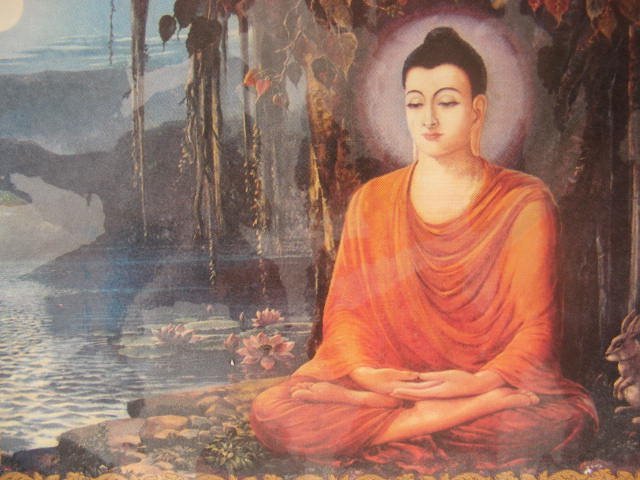










UPASAKA JAGATHEESAN CHANDRASEKHARAN
every second - everything is changing
( Nothing is permanent )
BE EVER HAPPY, WELL AND SECURE
MAY ALL SENTIENT AND NON-SENTIENT BEINGS BE EVER
HAPPY
MAY YOU ALWAYS HAVE CALM, QUIET,
ALERT,ATTENTIVE AND
EQUANIMITY MIND WITH A CLEAR UNDERSTANDING THAT
EVERYTHING IS CHANGING
29 04 2012 SUNDAY LESSON 595 FREE ONLINE eNālāndā
Research And Practice UNIVERSITY And
THE BUDDHISTONLINE GOOD NEWS LETTER by ABHIDHAMMA RAKKHITA through http://sarvajan.ambedkar.org
Dhammapada: Verses and Stories
Dhammapada
Verse 150 The Body Is A City Of
Bones
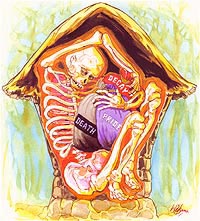
Verse
150. The Body Is A City Of Bones
This city’s made of bones
plastered with flesh and blood,
within are stored decay and death,
besmearing and conceit.
Explanation: This body is made of bones which form its
structure. This bare structure is plastered and filled with flesh and blood.
Inside this citadel are deposited decay, death, pride and ingratitude.
V.
FIVE TYPES OF BUDDHIST STUDY AND PRACTICE
MAHAYANA AND HINAYANA COMPARED
PURE LAND
BUDDHA RECITATION
EIGHT CONSCIOUSNESSES
ONE HUNDRED DHARMAS
http://en.wikipedia.org/wiki/Eight_Consciousnesses
Eight
Consciousnesses
The
Eight Consciousnesses is a
classification developed in the tradition of the Yogacara school of Buddhism. They enumerate the five senses, supplemented by the mind , the “obscuration” of the mind (manas), and finally
the fundamental store-house
consciousness, which is the basis of the other seven.
|
Contents Consciousness Transformations of consciousness Understanding in Buddhist Tradition Korea also References External links |
Etymology
The Sanskrit term for the Eight
Consciousnesses is Aṣṭavijñāna, from aṣṭa “eight”
and vijñāna “consciousness”. The Tibetan term is rnam-shes
tshogs-brgyad)[1]
The Sanskrit term for store-house consciousness is ālayavijñāna,
from ālaya “abode, dwelling”; Tibetan: kun gzhi rnam shes; Chinese: 阿賴耶識, Japanese: arayashiki (阿頼耶識?)
The Eight
Consciousnesses (Aṣṭa
Vijñāna)
All
Eight Consciousness are “aggregates” or skandha.
The
first six are the sensate “consciousnesses” plus the mind. The Yogacara School that espoused the Cittamatra
Doctrine
proffer two more consciousnesses:
- Eye-consciousnes (Tibetan: mig-gi
rnam-shes), seeing apprehended by the visual sense organs; - Ear-consciousness (Tibetan: rna’i
rnam-shes), hearing apprehended by the auditory sense organs; - Nose-consciousness (Tibetan: sna’i
rnam-shes), smelling apprehended through the olfactory organs; - Tongue-consciousness (Tibetan: lce’i
rnam-shes), tasting perceived through the gustatory organs; - Body-consciousness (Tibetan: lus-kyi
rnam-shes), tactile feeling apprehended through skin contact,
touch. - Ideation-consciousnes (Tibetan: yid-kyi
rnam-shes), the aspect of mind known in Sanskrit as citta or manovijñāna,
the “mind
monkey“;
the consciousness of ideation. - Manas
consciousness
(Sanskrit: klistamanas = klesha; Tibetan: nyon-yid
rnam-shes), obscuration-consciousness (”obscuration”,
“poison”, “enemy”; manas “ideation”,
“moving mind”, “mind monkey”), the consciousness which
through apprehension, gathers the hindrances, the poisons, the karmic
formations; - “Store-house
consciousness” (Sanskrit: ālāyavijñāna; Tibetan: kun-gzhi
rnam-shes), The seed consciousness (bi^ja-vijn~a^na), “the
consciousness which is the basis of the other seven”.[2] It is the
aggregate which administers and yields rebirth.[a]
Origins
and development
Pali Canon
The first five sense-consciousnesses along with the sixth
consciousness are identified in the Sutta Pitaka, especially the Salayatana Vagga subsection of the Samyutta Nikaya:
“Monks, I
will teach you the All. Listen & pay close attention. I will speak.”
“As you say, lord,” the monks responded.
The Blessed One
said, “What is the All? Simply the eye & forms, ear & sounds, nose
& aromas, tongue & flavors, body & tactile sensations, intellect
& ideas. This, monks, is called the All. [1] Anyone who would say,
‘Repudiating this All, I will describe another,’ if questioned on what exactly
might be the grounds for his statement, would be unable to explain, and
furthermore, would be put to grief. Why? Because it lies beyond range.”[3]
Yogacara
Main article: Yogacara
The Yogacara-school gives a detailed explanation of the
workings of the mind and the way it constructs the reality we experience. It is
“meant to be an explanation of experience, rather than a system of
ontology”.[4] Vasubandhu is considered to be
the sytematizer of Yogacara-thought.[5] Vasubandhu used the
concept of the six consciousnesses, on which he elaborated in the Triṃśikaikā-kārikā (Treatise in Thirty
Stanzas).[6]
Consciousness
According
to the traditional interpretation, Vasubandhu states that there are eight
consciousnesses:
- Five
sense-consciousnesses, - Mind
(perception), - Manas
(self-consciousness)[7], - Storehouse-consciousness.[8]
According
to Kalupahana, this classification of eight consciousnesses is based on a
misunderstanding of Vasubandhu’s Triṃśikaikā-kārikā by later
adherents.[9][b]
Aālayavijñāna
The ālaya-vijñāna forms the “base-consciousness”
(mūla-vijñāna) or “causal consciousness”. According to the
traditional interpretation, the other seven consciousnesses are
“evolving” or “transforming” consciousnesses originating in
this base-consciousness.
The store-house consciousness accumulates all potential
energy for the mental (nama) and physical (rupa) manifestation of
one’s existence (namarupa).
It is the storehouse-consciousness which induces transmigration or rebirth,
causing the origination of a new existence
Rebirth and purification
The store-house consciousness receives impressions from
all functions of the other consciousnesses, and retains them as potential
energy, bija or
“seeds”, for their further manifestations and activities. Since it
serves as the container for all experiential impressions it is also called the
“seed consciousness” (種子識) or container consciousness.
According to Yogacara teachings, the
seeds stored in the store consciousness of sentient beings are not pure.[c]
The store consciousness, while being originally immaculate
in itself, contains a “mysterious mixture of purity and defilement, good
and evil”. Because of this mixture the transformation of consciousness
from defilement to purity can take place and awakening is possible.[10]
Through the process of purification the dharma
practitioner can became a Arahat, when the four defilements of the mental
functions [d] of the
manas-consciousness are purified.[e] [f]
Tathagata-garbha thought
According to the Lankavatara Sutra and the schools of Chan/Zen Buddhism, the alaya-vjnana is
identical with the tathagata-garbha[g], and is
fundamentally pure.[11]
The equation of alaya-vjnana and tathagatagarbha was
contested. It was seen as “something akin to the Hindu notions of ātman
(permanent, invariant self) and prakṛti (primordial
substrative nature from which all mental, emotional and physical things
evolve).[12] The critique led by
the end of the eighth centuryto the rise of …
[T]he
logico-epistemic tradition [of Yogācāra] and […] a hybrid school that
combined basic Yogācāra doctrines with Tathāgatagarbha thought.
The logico-epistemological wing in part side-stepped the
critique by using the term citta-santāna, “mind-stream”,
instead of ālaya-vijñāna, for what amounted to roughly the same idea. It
was easier to deny that a “stream” represented a reified self.
On the other
hand, the Tathāgatagarbha hybrid school was no stranger to the charge of
smuggling notions of selfhood into its doctrines, since, for example, it
explicitly defined the tathāgatagarbha as “permanent, pleasurable, self,
and pure (nitya, sukha, ātman, śuddha). Many
Tathāgatagarbha texts, in fact, argue for the acceptance of selfhood (ātman)
as a sign of higher accomplishment. The hybrid school attempted to conflate tathāgatagarbha
with the ālaya-vijñāna.[12]
Transformations of consciousness
The traditional interpretation of the eight
consciousnesses may be discarded on the ground of a reinterpretation of
Vasubandhu’s works.
According to scholar Roger R. Jackson, a
“‘fundamental unconstructed awareness’ (mūla-nirvikalpa-jñāna)”
is “described […] frequently in Yogacara literature.”[13] , Vasubandhu’s work
According to Kalupahana, instead of positing additional
consciousnesses, the Triṃśikaikā-kārikā describes the transformations
of this consciousness:
Taking vipaka,
manana and vijnapti as three different kinds of functions, rather
than caharacteristics, and understanding vijnana itself as a function (vijnanatiti
vijnanam), Vasubandhu seems to be avoiding any form of substantialist
thinking in relation to consciousness.[14]
These transformations are threefold:[14]
Whatever, indeed,
is the variety of ideas of self and elements that prevails, it occurs in the
transformation of consciousness. Such transformation is threefold, [namely,][15]
The first transformation results in the alaya:
the resultant,
what is called mentation, as well as the concept of the object. Herein, the
consciousness called alaya, with all its seeds, is the resultant.[16]
The alaya-vijnana therefore is not an eight consciousness,
but the resultant of the transformation of consciousness:
Instead of being
a completely distinct category, alaya-vijnana merely represents the
normal flow of the stream of consciousness uninterrupted by the appearance of
reflective self-awareness. It is no more than the unbroken stream of
consciousness called the life-proces by the Buddha. It is the cognitive
process, containing both emotive and conative aspects of human experience, but
without the enlarged egoistic ermotions and dognatic graspings characteristic
of the next two transformations.[9]
The second transformation is manana,
self-consciousness or “Self-view, self-confusion, self-esteem and
self-love”.[17] According to the
Lankavatara and later interpreters it is the seventh consciousness.[18] It is
“thinking” about the various perceptions occurring in the stream of
consciousness”.[18] The alaya is
defiled by this self-interest;
[I]t can be
purified by adopting a non-substantialist (anatman) perspective and
thereby allowing the alaya-part (i.e. attachment) to dissipate, leaving
consciousness or the function of being intact.[17]
The third transformation is visaya-vijnapti, the
“concept of the object”.[19] In this
transformation the concept of objects is created. By creating these
concepts human beings become “susceptible to grasping after the
object”:[19]
Vasubandhu is
critical of the third transformation, not because it relates to the conception
of an object, but because it generates grasping after a “real object”
(sad artha), even when it is no more than a conception (vijnapti)
that combines experinece and reflection.[20]
A similar perspective is give by Walpola Rahula. According to Walpola Rahula, all the elements of the Yogācāra
storehouse-consciousness are already found in the Pāli Canon.[21] He writes that the
three layers of the mind (citta, manas, and vijñana) as
presented by Asaṅga are also mentioned in the Pāli
Canon:
Thus we can see
that ‘Vijñāna’ represents the simple reaction or response of the sense organs
when they come in contact with external objects. This is the uppermost or superficial
aspect or layer of the ‘Vijñāna-skandha‘. ‘Manas’ represents the aspect of its mental
functioning, thinking, reasoning, conceiving ideas, etc. ‘Citta’ which is here
called ‘Ālayavijñāna’, represents the deepest, finest and subtlest aspect or
layer of the Aggregate of consciousness. It contains all the traces or
impressions of the past actions and all good and bad future possibilities.[22]
Understanding
in Buddhist Tradition
China
Fa Hsiang and Hua Yen
Although Vasubandhu had postulated
numerous ālaya-vijñāna-s, a separate one for each individual person in the
para-kalpita, this multiplicity was later eliminated in the Fa
Hsiang and Hua Yen metaphysics. These
schools inculcated instead the doctrine of a single universal and eternal
ālaya-vijñāna. This exalted enstatement of the ālaya-vijñāna is described in
the Fa Hsiang as “primordial unity”[23].
The presentation of the three natures by Vasubandhu is
consistent with the Neo-platonist views of Plotinus and his universal
‘One’, ‘Mind’, and ‘Soul’.[24]
Chán
A core teaching of Chan/Zen Buddhism describes the
transformation of the Eight Consciousnesses into the Four Wisdoms.[h] In this teaching,
Buddhist practice is to turn the light of awareness around, from misconceptions
regarding the nature of reality as being external, to directly see one’s own nature. Thus the Eighth Consciousness is transformed into the Great Perfect
Mirror Wisdom, the Seventh Consciousness into the Equality (Universal Nature)
Wisdom, the Sixth Consciousness into the Profound Observing Wisdom, and First
to Fifth Consciousnesses into the All Performing (Perfection of Action) Wisdom.
See also
- Brahmavihara
- Doctrine
of Consciousness-Only - Mindstream
- Thirty Verses on Consciousness-only
- Three
kinds of objects - Anatta
in the Tathagatagarbha Sutras
Notes
1.
^ This idea may in some
respects be compared to the usage of the word “citta” in the agamas. In the early texts the sankhara-khandha plays some of the roles
ascribed to the store-house consciousness by later Yogacara thinkers.
2.
^ Kalupahana: “The above
explanation of alaya-vijnana makes it very different from that found in
the Lankavatara. The latter assumes alaya to be the eight
consciousness, giving the impression that it represents a totally distinct
category. Vasubandhu does not refer to it as the eight, even though his later
disciples like Sthiramati and Hsuan Tsang constantly refer to it as such”.[9]
3.
^ Each being has his own one
and only, formless and no-place-to-abide store-house consciousness. Our
“being” is created by our own store-consciousness, according to the
karma seeds stored in it. In “coming and going” we definitely do not
own the “no-coming and no-going” store-house consciousness, rather we
are owned by it. Just as a human image shown in a monitor can never be
described as lasting for any instant, since “he” is just the
production of electron currents of data stored and flow from the hard disk of
the computer, so do seed-currents drain from the store-consciousness, never
last from one moment to the next.
4.
^ 心所法), self-delusion (我癡), self-view (我見),
egotism (我慢), and self-love (我愛)
5.
^ By then the polluted mental
functions of the first six consciousnesses would have been cleansed. The
seventh or the manas-consciousness determines whether or not the seeds and the
contentdrain from the alaya-vijnana breaks through, becoming a
“function” to be perceived by us in the mental or physical world.
6.
^ In contrast to an Arahat, a
Buddha is one with all his seeds stored in the eighth Seed consciousness.
Cleansed and substituted, bad for good, one for one, his
polluted-seeds-containing eighth consciousness (Alaya Consciousness) becomes an
all-seeds-purified eighth consciousness (Pure consciousness 無垢識 ), and he becomes a Buddha.
7.
^ The womb or matrix of the
Thus-come-one, the Buddha
8.
^ It is found in Chapter 7 of
the Platform
Sutra
of the Sixth Ancestor Zen Master Huineng
and other Zen masters, such as Hakuin Ekaku, in his work titled Keiso
Dokuqui[25],
and Xuyun, in his work titled Daily
Lectures at Two Ch’an Weeks, Week 1, Fourth Day.[26]
Korea
The Interpenetration (通達) and Essence-Function
(體用) of Wonhyo (元曉) is described in the Treatise on Awakening Mahāyāna Faith (AMF):
The author of the
AMF was deeply concerned with the question of the respective origins of
ignorance and enlightenment. If enlightenment is originally existent, how do we
become submerged in ignorance? If ignorance is originally existent, how is it
possible to overcome it? And finally, at the most basic level of mind, the alaya
consciousness (藏識), is there originally purity or taint? The AMF
dealt with these questions in a systematic and thorough fashion, working
through the Yogacāra concept of the alaya consciousness. The technical
term used in the AMF which functions as a metaphorical synonym for
interpenetration is “permeation” or “perfumation (薫),”
referring to the fact that defilement (煩惱)
“perfumates” suchness (眞如), and suchness
perfumates defilement, depending on the current condition of the mind.[27]
Fatal error: Allowed memory size of 16777216 bytes exhausted (tried to allocate 86525 bytes) in /home/pegasus/SiteBlog-2.0.0-RELEASE_bundle/SiteBlog/wp-includes/functions-formatting.php on line 45

